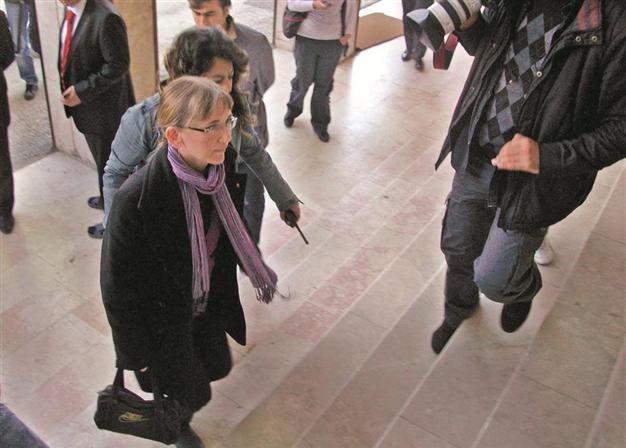Zirve case key to Armenian-Turkish journalist Dink, Father Santoro cases: Lawyer
ISTANBUL – Hürriyet Daily News

Suzanna Geske, the wife of Tillman Geske, murdered in Zirve Publishing House, heads to the courthouse to attend a trial in the eastern province of Malatya. DHA photo
The solving of the murders in Turkey’s recent past will shed light on key points of the deep state, according to Erdal Doğan, the lawyer for the Malatya Zirve Publishing House and Hrant Dink cases.
Doğan, who until recently was also an attorney for the Dink case, told the Hürriyet Daily News that the Zirve Publishing House trial was a key case that would unravel the last 60 years of Turkey’s deep state.
“Once the Zirve Publishing House trial is solved, a picture of Turkey’s past 60 years will appear. It will be clear how governments have been brought down, how ethnic structures have been played with, and how psychological propaganda has been made,” he said.
Three missionaries, a German, Tillman Geske, and two Turks, Necati Aydın and Uğur Yüksel, were tied up and tortured before their throats were slit at the Zirve Publishing House, a Christian publisher in Malatya, on April 18, 2007. Prior to that incident, Father Andrea Santoro was shot dead on Feb. 5, 2006 as he prayed in his church in the Black Sea city of Trabzon. In addition, Armenian journalist Hrant Dink was shot on Jan. 19, 2007 in front of the building of the Armenian-Turkish Daily Agos, where he was the editor-in-chief.
Doğan said that the latest indictment in the Zirve trial openly showed the cell structure of the Ergenekon coup plot group, adding that Christians - especially Armenians - were targeted. “The structure that committed the Zirve murders is the same structure that committed the Dink and Santoro murders. The government is targeted, and chaos is aimed for,” he said.
Doğan claimed that all of these cases had ties with the Special Warfare Department, which also helped organize the anti-Greek riots in Istanbul of Sept. 6-7, 1955.
“The structure of 1955 was developed in the 1990s, and a structure under the Special Forces Command was formed. We talk about a structure named Turkey’s National Strategies and Warfare Department (TUSHAD), which came up clearly with documents in the Zirve murders trial,” said Doğan.
‘Black and white’ forcesHe also claimed that the Turkish General Staff had approved of the existence of this structure of “black and white” forces. “The whites are established as civilians and they point out targets by disinformation,” he stated.
Retired General Hurşit Tolon and former Malatya Gendarmerie Regiment Commander Mehmet Ülger, who both were convicted in the recent Ergenekon coup case verdict, have also been added as suspects in the Zirve murders’ case. In addition, the court that is considering the case has also demanded the court files of the Ergenekon, Balyoz, JITEM and Musa Anter cases.
Upon being asked whether the government could be held responsible for these murders, Doğan said that as the government had signed the National Security Council decision of 2003, which perceived missionary works as a threat, it could be held responsible.
He said sufficient speed could not be given to the Dink case thus far as there had been considerable levels of disinformation. Doğan claimed that the 14th High Criminal Court looking at the case had reached its verdict by ruling at the very beginning of the trial that there was no organization behind the murder. He also stated that the 9th penal chamber of the Supreme Court of Appeals had “signed Dink’s death decree” by notoriously putting him on trial for breaching Article 301 of the Turkish Penal Code. “Therefore, neither of the courts are objective or independent,” said Doğan.
